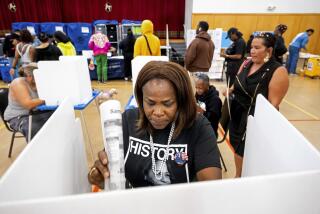From Certify to Butterfly--a New Voter Guide
- Share via
In America’s rush to pick a president--what’s the hurry, guys?--citizens far and wide have discovered the arcane lingo of the voting booth. But in our haste, the nuances of some electoral terms are lost, and other crucial terms have not been learned at all.
To right this wrong, The Times has consulted several electoral experts, none of whom is Doris Kearns Goodwin, and compiled this glossary to see you through America’s constitutional conundrum. Clip and save.
“Butterfly” ballot: Known officially as the Julia “Butterfly” Ballot, this is an absentee voting form for environmental activists who are living in California redwoods and cannot make it to the polls to vote for a King of the Hill because their arboreal home will be chopped down in their absence by the timber industry. Political analysts predict that once all the “Butterfly” ballots reach the ground and are counted, Green Party candidate Ralph Nader may reach the 5% threshold for federal campaign funds in 2004.
“Button fly” ballot: Also known as the “Levi’s 501” ballot, this voting form is respected for its durability. It is made of denim, and voters register their preferences by affixing copper snaps. Used only in Wyoming.
Certify: A state’s vote count is not official until it has been Certified. At this largely ceremonial event held most often in a state’s capitol, ballots are presented to the secretary of state by the supervisors of elections from each county. The secretary then signs off on the total tally, and distributes breath mints, with Retsin, to all in attendance. Traditionally, each participant consumes one mint then, and saves the rest of the specially designed roll for his or her collection.
Chad: The tiny squares--or circles--of paper that are supposed to fall out of punch-card ballots when a vote is cast. Ballots with attached chads can be misread by voting machines, and tabulated properly only when examined individually by canvassing boards. The boards have several labels for such chads:
* Hanging chad: A chad hanging to a ballot by a single corner. Not to be confused with a loitering chad, which just hangs on the corner for no reason.
* Swinging chad: A chad that gets around and doesn’t mind swapping votes, if you know what I mean.
* Pregnant chad: A chad that has been pushed--but not released from the ballot. All four corners remain attached. The debate lies in whether to count these ballots: Republicans maintain that a pregnant chad is a vote from its first casting until its Certification, generally nine months later. Democrats believe that a pregnant chad should be counted only when it is considered viable, long after the first trimester of its casting.
* Dimpled chad: Electoral experts agree this is the cutest of the chads.
* Chad & Jeremy: Seen mainly in British elections in the 1960s (but also for a brief time in the U.S.), this rare joining of chads has not been heard from since. Several Chad & Jeremy ballots remain uncounted from that period, but one member of the London canvassing board told The Times, “Yesterday’s gone. But I’ll get around to it when and if I can.”
* Tchad: The confetti-like bits of paper on punch-card ballots found in the central African republic of Chad.
Chard: Also known as Swiss chard, it is a succulent stalk with large leaves. A popular side dish at the Electoral College cafeteria.
Faithless electors: Members of the Electoral College who defy the will of their state’s voters and cast their ballots for another candidate. Not to be confused with Faith Hill electors, the class clowns of the Electoral College who cast their presidential votes for the blond country singer.
Hand recount: Double-checking every ballot by hand. Only suitable for precincts of 10 voters or less.
Hans recount: Double-checking an election by relying on the memory of 78-year-old Austrian immigrant Hans Beider, who is so grateful that he can vote in this country that he has volunteered at the polling place at the fire station near his house every year since he became an American citizen in 1962. Hans has a phenomenal memory and can recount, more or less, the names and votes of all 43 voters in his precinct. Note: This recount is only valuable if the race is close in Precinct 18-G of Muscatine, Iowa. This method can also take undue time, as Hans tends to digress and talk about fleeing Innsbruck during the war.
Manuel recount: This is the 15th stage in the recount process--a rarely employed survey of all voters named Manuel to see how they voted. This method originated during the Noriega regime in Panama.
Overvoting: A disorder in which the most civic-minded feel compelled to vote and vote and vote. They also vote compulsively in 1-900 telephone polls on MTV and in quizzes in Seventeen and Cosmopolitan magazines. Overvoting is essentially a self-esteem issue and is treatable with medication and counseling. See also UNDERVOTER.
Punch card: A coupon handed to each voter after turning in his or her ballot. It entitles the voter to enjoy refreshments and mingle with other voters in their precinct. That is when Hans, who ladles the punch, discerns how his neighbors voted, in the event that he is called upon later to recount them.
Stylus: The ancient Greek god of voting implements.
Undervoter: Those who vote only when their local soil and water conservation district has an open seat on the board--and then only for that office. Undervoters may not partake of the punch.
More to Read
Get the L.A. Times Politics newsletter
Deeply reported insights into legislation, politics and policy from Sacramento, Washington and beyond. In your inbox twice per week.
You may occasionally receive promotional content from the Los Angeles Times.










